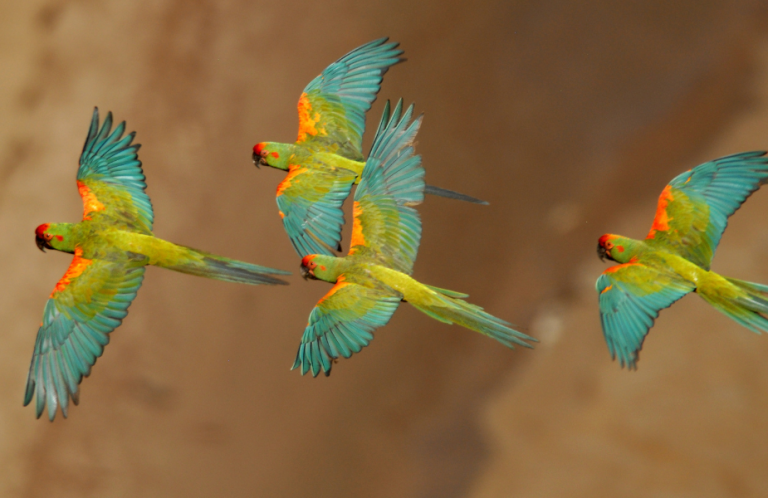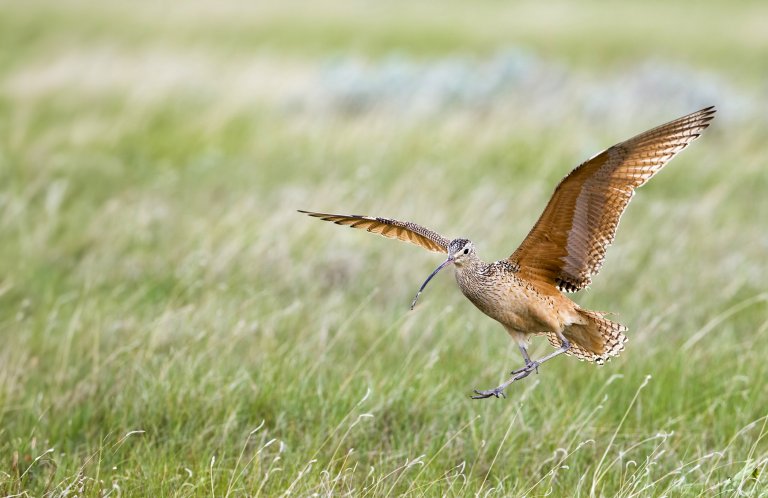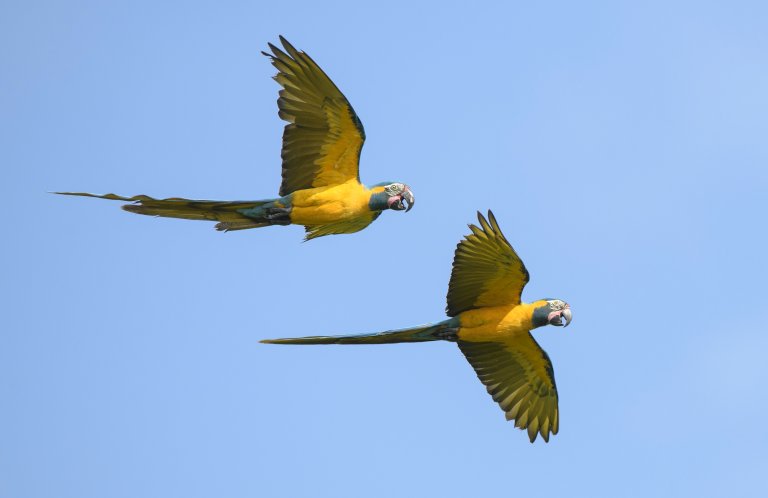Favorite Bird Sounds and Songs in the United States
Bird sounds — especially bird calls and bird songs — provide a natural soundtrack for our lives. Among other things, they give voice to the spring, sweeten the sunrise, and add mystery to the night. But with hundreds of bird species nesting, wintering, and passing through the United States, how do you decide on your favorites?
We tapped a team of ABC staff members with this challenge and they agreed on nine bird songs common to the United States. Their list ranges from songs of backyard birds (House Finch) and eastern woodlands (Wood Thrush) through open fields and prairies (Bobolink) to western arid lands (Canyon Wren).
Here are our top picks, in no particular order. Enjoy. And don't forget to let us know what you think on Facebook and Twitter!
Wood Thrush
Celebrated by poets and renowned as one of nature's greatest singers, the Wood Thrush (and its brethren, including the Swainson's Thrush) occupies a class of its own. This tireless singer is one of the first birds to be heard in the morning and one of the last to quit in the evening. But familiarity hardly dispels the beauty of the Wood Thrush's song. In fact, multiple listens inspire greater appreciation. The reason why may lie in the fact that males sometimes sing — and harmonize —by employing pairs of notes simultaneously from both sides of their y-shaped voice boxes.
Despite the Wood Thrush's large range in the eastern United States, its song is fading. In just the last 50 years, the Wood Thrush population has been reduced by half, due in part to widespread habitat loss. ABC's Migratory Birds and International programs are working with partners throughout Central and South America to improve land management and create protected bird reserves that support wintering Wood Thrushes, as well as other declining species such as the Golden-winged Warbler.
Yellow Warbler
The Yellow Warbler's bright springtime plumage is the perfect accompaniment to its sweet, cheerful song, which is often remembered with the mnemonic, “sweet, sweet, sweet, I'm so sweet.” Although this melody only lasts a second, Yellow Warblers aren't shy about sharing it again and again, often at a pace of ten times a minute. This makes the song something of spring and early-summer anthem for open, damp, and brushy spots across the continent.
Fortunately, the Yellow Warbler is not a threatened species, but it does face a series of growing threats. Among the most pervasive of these challenges are free-roaming domestic cats, which kill approximately 2.4 billion birds each year in the United States. ABC's Cats Indoors program works to combat this problem by educating the public, promoting science-based policies, and working with diverse stakeholders.
Song Sparrow
These small brown birds may be widespread and sport a “common” look, but their singing is anything but average. From region to region, Song Sparrows offer listeners a varied repertoire of songs and, like all great composers, they put a signature touch on their music, adding unique interludes of varying tempo between standard song phrases. How good is their singing? Some observers compare one of their songs to the beginning of Beethoven's Symphony No. 5.
Unfortunately, vocal skills do little to protect the Song Sparrow from growing anthropogenic (human-caused) dangers, including glass collisions, which are responsible for up to a billion bird deaths in the United States each year. ABC's Bird-Smart Glass Program, however, is working to combat this threat by testing preventative window products, advocating bird-friendly window legislation, and educating homeowners, architects, and lawmakers.
Bobolink
Despite the grueling distance they fly each spring — upwards of 6,000 miles — Bobolinks make their way north with a joyful song composed of tumbling notes. Having reached breeding grounds in the northern United States and southern Canada, male Bobolinks belt out two gurgling, metallic-sounding songs that last about 3.5 seconds each. These songs woo females, delineate territory, and, for appreciative human listeners, enliven fallow fields, meadows, and prairies in spring.
But these indefatigable globe-trotters are disappearing. In just the last 40 years, Bobolink populations have been reduced by half, due in part to a dramatic loss of their grassland habitat. ABC's Advocacy Program is helping Bobolinks and other prairie birds by promoting the continuation of key Farm Bill provisions such as the Conservation Reserve Program, which encourages grassland conservation on working farms.
Western Meadowlark
The gurgling songs of the Western Meadowlark grace fields, farms, and meadows throughout the western and upper Midwest, and are often included as background bird sounds in movies. The Western Meadowlark's rich, flute-like songs span a wide range of notes, making the species' eastern counterpart (the Eastern Meadowlark) sound plain in comparison.
Although Western Meadowlarks are still common, they face many threats, not least of which are poorly placed wind turbines. Wind turbines kill more than half a million birds each year and are expected to claim 1.4 million birds annually by the end of the coming decade. ABC's Bird Smart Wind Energy program is dedicated to reducing the impacts of turbines by helping private companies and government agencies make smarter decisions about the placement of wind energy facilities.
Canyon Wren
This subtly colored bird, which is found mainly among cliffs and canyons of the arid West, may not offer the most imposing appearance. But its cascading song, formed of a distinctive series of liquid-sounding whistles, is commanding as it bounces, amplified, from rock face to rock face.
The Canyon Wren is not known to drink water, but its insect diet provides sufficient hydration to keep the bird in excellent singing form!
Gray Catbird
The Gray Catbird is a robust singer able to draw out songs for up to ten minutes. Many times the catbird's halting song, which is composed of a mix of whistles, squeaks, gurgles, and other sounds, is delivered from a high perch where it serves as a territorial warning. An eclectic performer, the Gray Catbird draws inspiration from a variety of sources, including other bird sounds, machinery, and even frog calls. But the Gray Catbird is best known for its cat-like mewing call, which accounts for its name.
Although the Gray Catbird remains a common species, it benefits from many of ABC's conservation programs. ABC's BirdScapes program, which launched in 2017, helps conserve wintering grounds for the Gray Catbird and other species by promoting sustainable livelihoods and the responsible management of critical bird habitat.
Common Loon
Few bird sounds are as mournful or memorable as the Common Loon's yodel. Each yodel is specific to a male loon, but even among individuals this vocalization does not remain static: When Common Loons move to new territory, their yodel often changes with the landscape.
Yodeling, however, isn't the Common Loon's only claim to fame. They also produce a series of trembling laugh-like notes to sound the alarm or announce their arrival.
House Finch
Since their introduction in New York from the western United States in the 1940s, House Finches have been sharing their exquisite song with an ever-growing human audience, which now includes most of the eastern United States. Among North America's most widespread songbirds, these resolute singers are nothing if not adaptable. Regardless of the region they occupy, male House Finches take to high perches, where they sing with gusto for extended periods. Their fast-paced song bounces up and down, usually ending with a slurred note that helps distinguish them from Cassin's and Purple Finches.
Notwithstanding their enormous range, House Finches, like most birds, are threatened by pesticides. The most widely used pesticides in the United States, neonicotinoids, or “neonics” as they are popularly known, are extremely dangerous for birds. A single seed treated with neonics is enough to kill a songbird. Lesser amounts can cause birds to become emaciated and impair their reproduction. ABC's Pesticides program aims to protect House Finches and other birds by working to cancel or restrict registrations of neonics and other deadly pesticides.


















































